Lift and Coast
One subject dominated the airwaves – or at least what we got to hear of them - fuel saving. After 2014, new engine rule limiting cars to 100kg of fuel during races and a maximum fuel-flow rate of 100kg per hour forcing drivers to 'lift and coast', to save fuel throughout the race especially during races where fuel usage is high, like Canadian Grand Prix. It's not just the fans who are becoming fed up with "lift and coast", drivers and team bosses are also unimpressed.
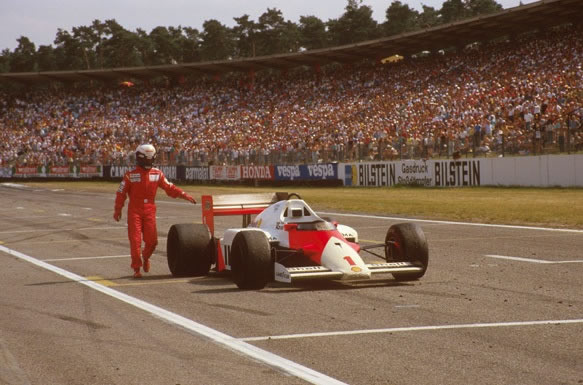 |
German GP 1986, Hockenheim, Alain Prost ran out of fuel on the penultimate lap, pushing the car home. (McLaren MP42C TAG Porsche). He dropped from 3rd to 6th position. |
Fuel saving has always been a factor in racing but term "lift and coast" has been common talking point in Formula One for the past few years. It was used also during the early days of the V8 and V10 era but became more prominent at fuel limited races following the ban on in-race refuelling from 2011. That's when teams started carrying a fuel load for the entire race - and carrying less means the car will be faster from the start. It is now more common because, under the 100kg race fuel allowance, teams would never fuel a car to go flat out every lap - that's just not the quickest way to run a race. A team will always plan to start the car as light as possible, go flat out and then save fuel later on once the race order settles down after the pit stops. Also, radio communications between car and pit wall are widely broadcasted and fans can now clearly hear about fuel saving instructions. In past times all communications was scrambled and highly guarded secret, so fans didn't know what is exactly going on.
Advances in telemetry ensure teams have a much more accurate understanding of fuel usage than in the 1980s when there was an element of guesswork involved, and when cars parked by the side of the track, with empty tanks, were a common sight. Drivers have always had to save fuel, but perhaps not to the extent that we are witnessing (with the benefit of listening to team radio) at the moment. And what is the point to get first at one lap before race end and then remain parked without fuel. Point is to finish the race as fast as possible. And weight is key.
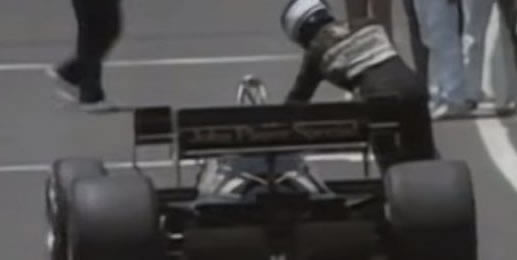 |
Nigel Mansell collapsed as tried to push his Lotus over the line at the Dallas Grand Prix in 1984 |
Evidently, the concern that too much fuel saving is bad for racing is not new to F1. Nor was this practice absent under the previous engine regulations. In the last season with V8 engines, some teams would fill their cars with up to 10% less fuel than they needed to complete a race distance, then "lift and coast" to make savings when needed. Fuel-saving was and will always be a priority in F1.
"Lift and Coast" and fuel saving does not exactly set the adrenaline flowing. The reality is that F1 in 2014/15 is becoming synonymous with racing drivers having to focus on conserving fuel by driving cautiously.
What is actually "lift and coast"? "Lift and coast" is the most effective technique for driving flat out but doing so in an efficient manner that enables fuel consumption targets to be maintained, while minimizing time loss and reducing the opportunity for a rivals to take advantage. Letting go of the accelerator and use engine braking to save fuel during race, as opposed to flat-out driving. F1 racers do not "lift and coast" during qualifications but do "lift and coast" during the race. This technique achieves a faster overall race time than would be possible by carrying additional fuel and driving "flat out" from start to finish.
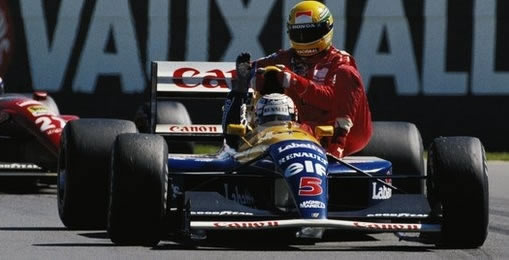 |
Nigel Mansell driving the No5 Canon Williams Renault FW14 V10 gave a lift to Ayrton Senna when the Brazilian's McLaren ran ran out fuel at the 1991 British GP |
Just as important is what "lift and coast" is not. It's not coasting into a corner a long way below the theoretical limit of performance. Car is still always on the limit trough the corner or extremely close to it!
The basic principle is this: running less fuel saves weight - and a lighter car is a faster car. If you've got 100kg of fuel to complete a race but can run half the distance with "lift and coast", you might be able to use 3kg less. If starting that race 3kg lighter enables a driver to go a tenth of a second per lap quicker without any "lift and coast", by the time they're 30 laps into the race they might be three seconds further up the road. This could buy a position at the pit stops, gaining vital track position, and the driver can then save fuel later to compensate. So, teams use "lift and coast" strategically to produce the most effective race strategy.
In his BBC Sport column in March last year, Hamilton explained what it means:
"You save most fuel by lifting and coasting in the heavy braking zones at the end of long straights into slow corners.
"When you're driving absolutely flat out, such as on a qualifying lap, you would brake at, say, 80m from the corner, come straight off the throttle and get on the brakes, almost instantly together.
"But on a fuel-saving lap in the race you'll lift at, say, 200m, and coast to the braking zone."
His colleague Niko Rosberg pointed out:
"Lift and coast is the most efficient way to save fuel - they even did it in the 80s," said the Mercedes driver. "I remember my Dad (Keke) doing it when he was racing with Alain Prost at McLaren. They had to save fuel because everybody was running out at the end of races. So nothing has changed there, just that it's become more professional, more accurate, and more detailed."
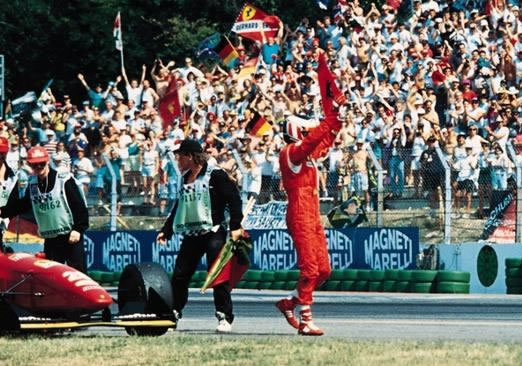 |
Berger salutes the fans after his car runs out of fuel returning to Parc Ferme, German GP 1994, Ferrari 412T1 |
Tires, brakes and fuel have always been limiting factors for F1 drivers. Lifting and coasting hasn't simply come into existence overnight, as drivers and engineers have used the tactic for years. In qualifying trim a driver will choose his braking point based on the maximum amount of apex speed he can carry, whilst the penalty of carrying additional fuel on lap time during a race ("fuel effect") means that the engineers will calculate how much (or better to say "how less") fuel a driver can get away with by doing some "lift and coast" throughout the race. During the V8 era there was no upper limit on fuel weight and teams generally ran somewhere between 120-160kg's of fuel depending on the circuit, but remember those engines were much hungrier, often consuming a little more than 2kg's per lap, so with more fuel onboard, but with also higher consumption, the drivers still needed to manage their fuel to make a race distance. And any kilo of fuel you carry around will cost you lap time. The enemy of any race car driver or engineer is weight, which means carrying around more fuel than you need isn't the optimal way to go racing, after-all 10kg's of fuel is worth around 3-4 tenths in lap time, creating a strategic offset whereby sometimes it's actually better to be slower, saving fuel, than it is to be racing flat out with more fuel on board. There’s an obvious trade-off here: if teams fill in the full allocation of fuel, they increase the starting weight of their car by over 14%. More fuel makes it easier for them to reach the end of the race, but that extra weight means slower lap times and a higher demand on tires and brakes.
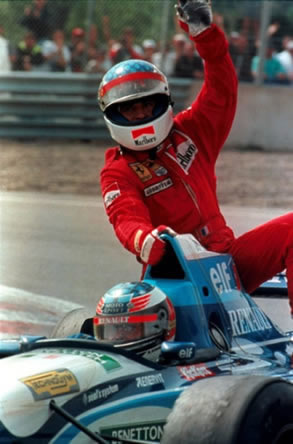 |
Jean Alesi parked the car run out of the fuel. Whilst being given a lift back to the pits by Michael Schumacher, he celebrates his only victory in Formula One for Ferrari. Montreal, 11 June 1995 |
Once a car has accelerated up to full speed, it will run at a full fuel flow rate of 100kg/hr - the maximum allowed under the regulations - meaning that the engine is producing maximum power output for that period. The driver will then lift off the throttle and in the same moment slam the brakes and go straight into the braking zone, through the corner apex, and accelerate out again. Apex speed will be exactly the same and the latter part of the braking curve will be exactly the same, so there is no further loss. This is how to produce the fastest theoretical lap time.
In terms of fuel consumption, however, the most effective way to use less fuel on a straight is to get down it as quickly as possible (hit the full speed mark as soon as possible) and then lift off throttle towards the end of the straight, before the natural braking point. At this point, fuel consumption falls to practically zero. During this period between full power and apex of the corner, the car is decelerating purely from aerodynamic and tire drag - and pretty quickly, too. When a car is travelling at 300km/h there's an awful lot of drag force on the car - a deceleration of 1.1g, that's as hard as a Z06 Corvette brakes in a full-ABS emergency stop. When a driver deploys "lift and coast" for a distance of an additional 50m, for example, the car is completely off throttle for that period. So, as opposed to covering the last 50m at 100kg/hr fuel consumption, it's doing so at 0kg/hr. In terms of the time taken to cover 50m at 300km/h as opposed to 280km/h, we're talking about a difference of mere hundredths of a second. But the fuel saving is significant - a ten or so grams each time. Once the coasting distance has been covered, the driver then picks up the original braking profile. This is far more than simply coasting into a corner as might be perceived... Then, when the driver picks up the normal braking profile once more, they are rejoining the same trajectory that they would normally follow. Overall, the effect on lap time (time penalty) when doing small amounts of "lift and coast" is practically zero. It's only when deploying higher levels of "lift and coast", like we saw at the end of the Canadian Grand Prix 2014, that it really becomes noticeable. Even in the most extreme cases, such as Montreal which is a fuel limited track, which without a safety car periods exacerbated the fuel usage issues, the maximum you would expect to lose is around three tenths of a second per lap - still a relatively small number - and, generally, when a driver is asked to do lift and coast they'll be losing in the region of half a tenth to a tenth.
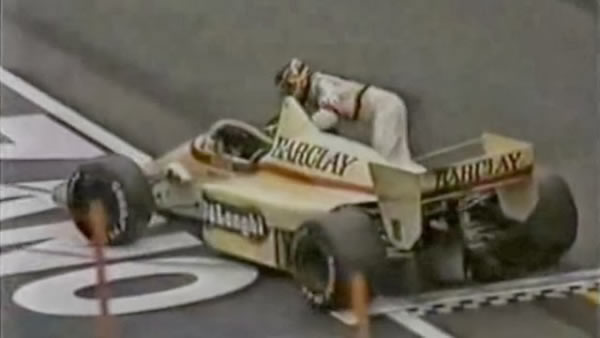 |
From Epic Formula 1: The day when everyone ran out of fuel, 1985 San Marino Grand Prix, Imola |
Another reason lift and coast featured prominently in Montreal is that it is very good for saving brakes. When travelling at high speed, energy increases as a square of the speed - so, as you double your speed, you produce four times the energy. When a driver lifts off rather than hitting the brakes, they're letting the air absorb some of that energy as drag on the car and the tire - without putting any energy into the brakes. That initial phase of braking, when the car is travelling at the highest speed, is where energy levels are at their highest. So, lift and coast is also incredibly effective at managing brake temperatures. And also to reduced strain on the engine itself and to help bring engine temperatures down.
Yes, now you will say that saving brakes and "lift and coast" will compromise energy harvesting on the MGU-K (the process by which the battery is charged when the motor works as a generator) will be lost because for a period of the potential maximum braking zone the car is coasting. Lifting off rather than braking does mean that some charge is lost - but again, the net energy benefits are always going to be positive. The MGU-K has a certain power capacity and harvests as a function of how long that power is generated under braking. There aren't many circuits where a driver will struggle to harvest the full 2MJ/lap energy allocation from the MGU-K.
However, much the fans might not like it, the reality is that fuel-saving has always been a part of Formula 1, and always will be. And that has very little to do with the fact that the current regulations include a fuel restriction. It will always be quicker to start a car with less fuel and ask the driver to fuel-save at some point than to fill it with enough fuel to drive flat out to the end. That's because of the extra weight of the fuel. It doesn't matters what the engine rules are, how much fuel the teams are allowed, or how long the races are. That is just engineering reality. Would fuel-saving disappear if refueling was reintroduced for season 2017, as the Strategy Group desires? Not at all. In IndyCar, where refueling is allowed, drivers are often heard being given their fuel mileage figures so they can stretch their fuel between stints in order to make fewer pit stops. And BTW, fuel saving was in play in Formula 1 also when refueling was allotted.






